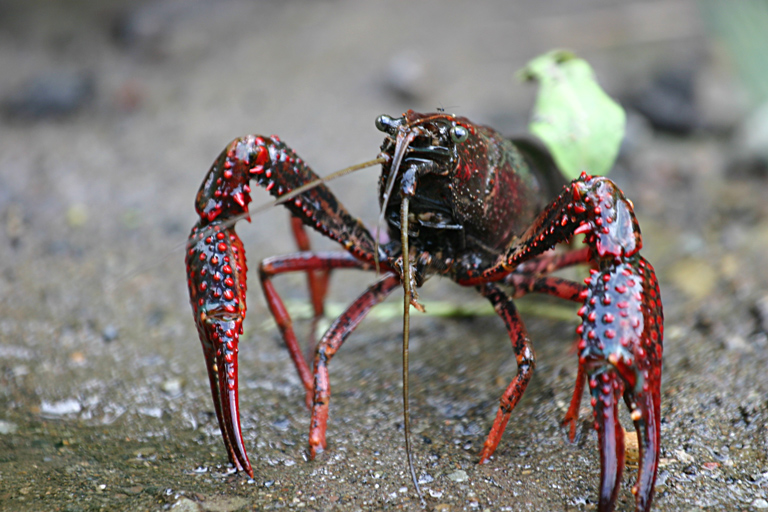- Procambarus clarkii
Taxobox
name = "Procambarus clarkii"

image_width = 250px
status = LR/lc
regnum =Animal ia
phylum =Arthropod a
subphylum = Crustacea
class =Malacostraca
ordo =Decapoda
infraordo =Astacidea
familia =Cambaridae
genus = "Procambarus "
subgenus = "P. (Scapulicambarus)"
species = "P. clarkii"
binomial = "Procambarus clarkii"
binomial_authority = Girard, 1852"Procambarus clarkii" is a freshwater
crayfish species , native to theSoutheastern United States , but found also on other continents, where it is often an invasive pest. It is known variously as the red swamp crawfish, red swamp crayfish, Louisiana crawfish or Louisiana crayfish.Range and range expansion
The native range of "P. clarkii" is along the Gulf Coast from northern
Mexico to theFlorida panhandle , as well as inland, to southernIllinois andOhio . It has also been introduced, sometimes deliberately, outside its natural range to countries inAsia ,Africa ,Europe and elsewhere inthe Americas . In northernEurope , the populations are self maintaining but not expanding, while in southernEurope , "P. clarkii" is multiplying and actively colonising new territory, at the expense of the native crayfish, "Astacus astacus " and "Austropotamobius spp.". Individuals are reported to be able to cross many miles of relatively dry ground, especially in wet seasons, although theaquarium trade and anglers may have hastened the spread in some areas (it is believed that anglers using "P. clarkii" as bait introduced it to the American state ofWashington ). Attempts have also been made to use "P. clarkii" as a biological control organism, to reduce levels of thesnail s involved in the life cycle ofschistosomiasis , leading to the dispersal of "P. clarkii" in, for instance,Kenya .Ecology
"P. clarkii" is most commonly found in warm
fresh water , such as slowly-flowingriver s,marsh es, reservoirs,irrigation system s and rice paddies. It is considered to be the most ecologically plastic species in the OrderDecapoda , and is able to grow quickly even in only seasonally present water, being able to tolerate dry spells of up to four months. "P. clarkii" grows quickly, and is capable of reaching weights in excess of 50 g, and sizes of 5½–12 cm long. It is also able to tolerate slightly saline water, which is unusual for a crayfish. The average lifetime of Procambarus clarkii is 5 years. It is known that some individuals have reached ages (in nature) over 6 years.Economic importance
The rapid growth and ecological tolerance of "P. clarkii" facilitates a large farming industry in
Louisiana , worth millions of dollars annually, and with more than 500 km² in cultivation. Harvests of "P. clarkii" account for a large majority of the crayfish produced in theUnited States and elsewhere. "P. clarkii" has also been introduced elsewhere for cultivation, such asSpain , where its success is attributable to its ability to colonise disturbed habitats that would be unsuitable for the native crayfish. "P. clarkii" is also marketed by biological supply companies for teaching and research.Ecological impacts
The burrowing activities of "P. clarkii" can lead to damage to water courses and to crops, particularly
rice crops, and its feeding can disrupt native ecosystems. It may out-compete the native crayfish species, and is a vector for thecrayfish plague fungus "Aphanomyces astaci", for crayfish virus vibriosis and a number ofworm s parasitic onvertebrate s.Miscellany
"Procambarus clarkii" was named by
Charles Frédéric Girard in honour of John H. Clark, who surveyed the US-Mexican border in 1851.Fact|date=January 2008References
*cite journal |quotes=no |author=Girard C. |year=1852 |title=A Revision of the North American Astaci, with Observations on Their Habits and Geographic Distribution |journal=Proc. Acad. Nat. Sci. Philad. |volume=6 |pages=87–91
*UCN 2007. 2007 IUCN Red List of Threatened Species.. Downloaded on 14 October 2007.
*cite journal |quotes=no |author=M. James Norrocky |year=1991 |title=Observations on the Ecology, Reproduction and Growth of the Burrowing Crayfish Fallicambarus (Creaserinus) fodiens (Decapoda: Cambaridae) in North-central Ohio |journal=American Midland Naturalist |volume=125 |pages=75–86 |doi=10.2307/2426371External links
Wikimedia Foundation. 2010.
